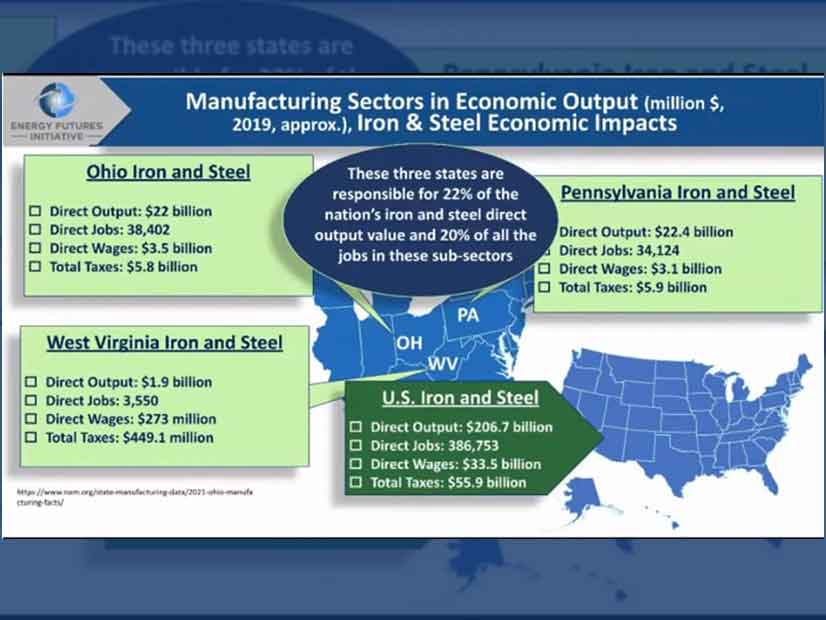Shale gas, once called a “transition fuel,” and increasingly shipped overseas where prices are higher, is a key to achieving U.S. net-zero carbon emissions by 2050, a key Biden administration appointee said this week.
“We have to tailor the path forward for a decarbonized energy and industrial future based on the existing assets,” said Brian Anderson, director of the National Energy Technology Laboratory, who was appointed executive director of the administration’s Interagency Working Group on Coal and Power Plant Communities and Economic Revitalization in April.
Anderson was one of nearly a dozen speakers during a two-hour virtual program hosted this week by AFL-CIO President Richard Trumka and former Energy Secretary Ernest Moniz, now a principal with the Energy Futures Initiative think tank.
The mission of Anderson’s working group is to make sure the shift to a clean energy economy does not leave behind the existing industrial workforce and their local economies, whether they were based on coal mining, power generation or heavy industry — a centerpiece of Biden’s “Build Back Better” agenda.
“This region, blessed with a lot of natural gas, has a great pathway through decarbonized blue hydrogen,” Anderson said.
“When we look at the different pathways for decarbonizing the grid by 2035 and … the economy by 2050, a large component of that’s going to require the commercialization of carbon capture utilization and storage.”
Gas production in the Marcellus and Utica shales would be fed to an expanded “steam reforming” industry that pulls hydrogen out of methane in a high-heat process, leaving behind carbon dioxide that would have to be injected deep underground in another industrial process that would also create new jobs.
Anderson said hydrogen could substitute for natural gas in steel making, cement making and other industrial applications that require a lot of energy, and which today pump enormous amounts of CO2 into the atmosphere.
Noting that the Department of Energy has been working on carbon sequestration for 20 years, Anderson said the “blue hydrogen” made from natural gas is only a fraction of the cost of “green hydrogen,” produced through electrolysis of water, using electricity generated by wind or solar.
A fellow panelist, Brad Markell, executive director of the AFL-CIO Industrial Union Council, said workers employed in the natural gas industry have skills that could easily transfer to hydrogen as well as carbon capture and sequestration.
“Unions are ready to go for CCS and hydrogen. Our training programs [can] accommodate this,” he said.
“The fact is that we need baseload power. We need industrial heat. We need regionally focused solutions that are going to build on the strengths of the Ohio River Valley to preserve high-paying, good industrial jobs, heavy industry industrial jobs and energy-intensive industry,” Markell said.
Lee Beck, international director for carbon capture with the Clean Air Task Force, said the substitution of hydrogen for methane and carbon sequestration will be crucial in the coming decades as the nation attempts to decarbonize industry.
“From our perspective, we think that carbon capture and hydrogen are important for achieving net-zero emissions globally. The most important thing right now is to make sure that we can commercialize these technologies so we can start creating jobs in the near term,” she said.
Moniz agreed that hydrogen will have a star role in cleaning up heavy industry.
“We all know that we will need to clean our electricity system [and] will need to do some electrification in other sectors. But we also know we are going to have to supplement that by approaches that at least have the characteristics of today’s fuels. And that’s where we see hydrogen coming in as an essential compliment to low-carbon electricity,” he said.
Trumka focused on the impact that cleaning up heavy industry will have on ordinary people.
“We see working people who have suffered a long-term hollowing out of our country’s industrial base, but now we’re at an inflection point. We have an opportunity to define a 21st century industrial policy to modernize our energy and manufacturing sectors so that our children and grandchildren inherit a livable planet and broadly shared prosperity. And it starts now,” he said.
The overall thrust of event was “deployment, deployment, deployment,” said former EPA Administrator Gina McCarthy, now the White House National Climate Adviser, who made an appearance along with Ohio Sen. Sherrod Brown (D) and West Virginia Sen. Joe Manchin (D).
McCarthy said the administration wants to fund 10 “pioneer demonstration facilities using carbon capture retrofits” and 15 clean hydrogen demonstration projects.



